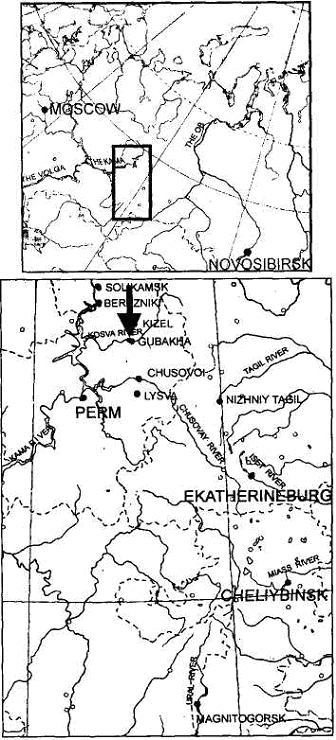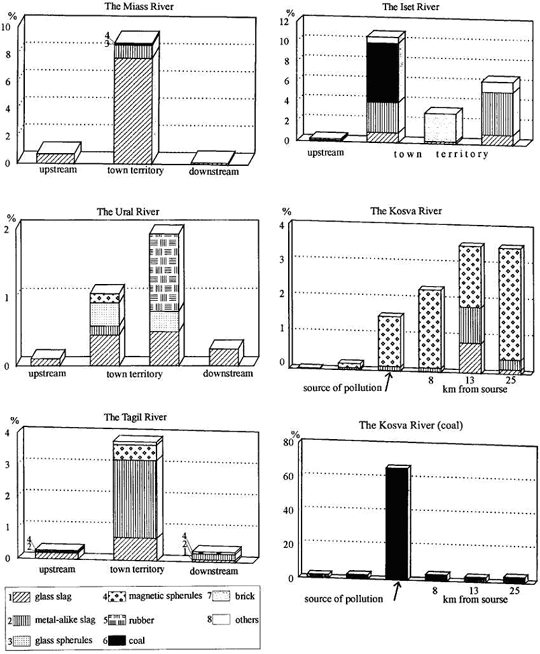Лаборатория геологии техногенных процессов
Maximovich N.G., Menshikova E.A., Osovetskiy B.M. Hard technogenic components in alluvium and environment // Proceedings of the 8th International Congress. International Association of Engineering Geology, Vanconver, 21-25 Sept. 1998. Rotterdam; Brookfield, 2000. - P.4579-4582.
HARD TECHNOGENIC COMPONENTS IN ALLUVIUM AND ENVIRONMENT
N.G. Maximovich, E. A. Menshikova & B. M.Osovetskiy
ABSTRACT: Technogenic components in alluvial sediment composition are investigated in the Urals (Russia). The problems of their classification, migration and ecological interpretation are discussed.
Modern alluvial sediments of the territories with big industrial and agricultural enterprises are composed not only natural particles but technogenic ones too. The main places of their concentration are little river and stream valleys within city-industrial agglomerations. As a rule industrial enterprises as the sources of technogenic components are situated on the river banks. Their wastes are rather different and contain complex mixture of artificial products. The last contaminate alluvial sediments during channel erosion. Big masses of these components are transporting downstream and may get to the seas and lakes.
A lot of researchers payed attention to the presence of anthropogenic products in natural sediments (McCrone 1967, Rust & Waslenchuk 1976, Kozak et al. 1995, etc.). They have found complex ecological situation at the ancient mining territories because of the influence of technogenic products in sediment composition to ecosystems. Classification of technogenic particles in alluvium may be work out using several principles of systematization. One of them is chemical composition of fragments. Such classification is similar to a mineralogical one. In addition to this principle it is expediently to subdive technogenic grains into two types: homogeneous and heterogeneous. The first type includes such classes as pure elements (lead, zinc, mercury, iron, tin, copper, etc.), silicates (glass, slag), phosphates (fertilizer), sulfates, chlorides (salt), oxides and hydroxides (magnetic spherules), organic compounds. The second type includes fragments of ores and rocks, intergrowths of mineral grains and artificial products.
The next principle of classification uses the kind of industrial activity of population. There are several types of technogenic components subdivided on the basis of such approach (industry, agriculture, energy, transport, mining, etc.).
River sediments accumulate technogenic particles and transport them for a long distance. The main factors determining technogenic component migration downstream are dynamic characteristics of river flow, physical and chemical properties of particles, geomorphologic situation in the river valley. Artificial products in sediment composition may be differentiated according to their specific gravity, size, morphology, reological properties and others. The sorting process for technogenic compounds accomplishes with consideration their hydraulic equivalence. As a result there are alluvial layers with very high level of concentration of technogenic grains. On the contrary, some layers of alluvium are rather poor in technogenic part.
Migration of technogenic particles along river valleys is controlled by hydraulic size (settling velocity), solubility, hardness, morphology. There are two main forms of migration: 1) in bottom load and 2) in suspended load. Migration in bottom load is typical for coarse grains (for example, slag) or for particles with very high specific gravity (metallic fragments, magnetic spherules, etc.). They usually may be concentrated in different zones of channel alluvium (near contact between alluvium and bed rock, at the middle part of alluvial section, on the beach, and so on).
Fine particles of technogenic products migrate in suspended load. They include such materials as coal, ash, colloidal hydroxide flakes, technogenic dust, flat waste individes, and so on. The usual places of their accumulation are fine-grained sandy and silty layers in the flood plains, thin stratums of sediment at the river bar.
Distance of migration first of all depends on hydraulic properties of particles. The last are controlled by grain size, specific gravity, morphology and character of grain surface. The second group of factors are physical properties of particles, such as hardness, cleavage, fracture system, viscosity, etc. Some technogenic particles migrate to the distance of several hundred kilometers (in suspended load), the other have very small migration capacity.
City-industrial agglomerations around the world became the real centers of anthropogenic pollution of river sediments. This process has cumulative character that is result in replacement natural alluvial sediments by technogenic-natural ones. Properties of such sediments do not coincide with that of natural ones. It is necessary to take into opinion presence of toxic compounds in sediments on the territories of city-industrial agglomerations and surrounding places.
All factors of integration, differentiation and migration of technogenic products in alluvial sediments result in definite assemblage of anthropogenic particles. The character of such combinations (technogenic associations) is inherited from industrial or agricultural specialization of region. Later on it is transformed due to river activity. The most usual associations are composed by coal, ash, glass or magnetic spherules, slag, brick.
The researchers of Perm University from 1991 have been realizing the special program of technogenic influence investigation for river sediments (Osovetskiy & Menshikova 1996, 1997, Maximovich 1997, Maximovich et al. 1990, 1995, Lepikhin et al. 1997). The program includes different topics of investigation such as the followings:
- technogenic associations in river sediments and their relation with human activity,
- city-industrial agglomeration influence to the nearest territories, migration process of technogenic particles along river valley,
- valuation of ecological situation on the territory on the basis of analysis of suspended load composition, classification of technogenic products at river sediments,
- investigation of technogenic-natural systems at river valleys.
According to the program river sediments on the territories of main city-industrial agglomerations of the Urals were investigated (Fig. 1). More than 300 samples were taken from alluvial sediments including pebble-gravel, sand, silt and clay varieties. Technogenic components were studied under binocular microscope. The samples of silt and clay were analyzed using spectral method.
Technogenic products from pebblygravel sediments were concentrated with the help of spiral separator. The typical directions of industrial activity in the Urals are metallurgical and chemical industry, mining, electric power producing, oil and gas extraction, mechanical engineering, etc. The transport arteries are rather extent. There are pipelines, railways, airlines and high roads among them.The amount of technogenic products at river sediments is rather changeable. It is controlled by presence of river systems near big enterprises with a lot of wastes. Of course, system of polluted water refining influences to the sediment composition. Sometimes technogenic products prevail in sediments, especially in silt. In the mining regions scale of sediment pollution is very high. Near coal mines (Kizel-Gubakha agglomeration) the technogenic association of ash, magnetic spherules, coal particles and slag was found in river sediments (Fig. 2). High percentage of rare elements (Sc, Be, Y, Yb, Nb, Li, La) in soils is typical there.
 Figure 1. The region of investigation

Figure 2. Technogenic associations in the alluvial sediments of the Urals
Metallurgical profile of industrial activity (Magnitogorsk, Lysva, Chusovoi regions) is connected with another association of technogenic products. It includes special varieties of slag, metallic fragments, glass and magnetic spherules. As to rare elements Zn, Pb, Cu, Cr, Mn, P, Bi, Mo, Sr, Sn are rather usual for silt and clay sediments. Besides, such toxic elements as As, Sb, Cd appear there. On the whole for alluvial sediments of the Urals territory Cr - Cu - Pb - Zn - Ni - Sn element technogenic association is found.
Technogenic pollution of river sediments is rather dangerous for population health especially at mining territories. In the Urals there are mines of salt (Solikamsk-Berezniki region), coal (Kizel-Gubakha), chromite (Sarany). At previous period (XVIII-th century) there were copper and gold little mines. Suspended particles of river flows concentrate toxic elements. For example, Be is found at the Kosva River sediments; Cd, Bi and Sb are typical for the Ural River silt; Hg is presented at the Kama River tributaries sediments. Ferriferous hydroxides in colloidal phase saturate river suspension at coal mine territory.
Some technogenic products are soluble in water (fertilizer, slag, salt, carbonates and sulfates). That is one of the reasons why drinking water of many sources is polluted by dangerous for health different elements (Al, Cr, Ni, Cu, Pb, Zn).
It is necessary to pay attention to ecological situation at river ponds and reservoirs. They accumulate a great mass of silt and clay material from huge territory. In the Urals they have been constructed near big industrial enterprises with the purpose of technical water supply. There is no doubt that at the bottom of ponds and reservoirs we can find different technogenic products. Their amount is increasing every year. The system of ecological situation monitoring at city-industrial agglomerations has to include sampling of suspended load. Nowadays this conclusion is not ordinary practice for nature protection survices.
References
Kozak, J., Janku, J. & Jehlicka, J. 1995. The Problems of Heavily Polluted Soils in the Czech Republic: A Case Study. Heary metals. Problems and Solutions. Springer: 288-300. Lepikhin, A.P., Sadokhina, E.L., Miroshnichenko, S.A., Maximovich, N.G. & Menshikova, E.A. 1997. Bottomset bads influence on formation of water quality in rivers of the West Urals. Intern. Conf. on Contam. Sed. Rotterdam: 325-331.
McCrone, A.W. 1967. The Hudson River estuary: sedimentary and geochemical properties between Kingston and Haverstraw, New York. J. Sediment. Petrology 37(2): 475-486. Maximovich, N.G. 1997. Geochemistry of coal deposits and environment. VestnikPerm Univ. Geology 4: 171- 185.
Maximovich, N.G., Blinov, S.M. & Menshikova, E.A. 1995. The influence of Kizel coal basin on the river ecology conditions. Abstr. XIII Intern. Cong, on carboniferous-permian. Krakov: 99.
Maximovich, N.G. & Gorbunova, K.A. 1990. Geochemcal aspects of the geological medium changes in coal fields. Proc. 6 Intern. Cong. Int. Ass. Eng. Geol. Rotterdam: 1457-1461.
Osovetskiy, B.M. & Menshikova, E.A. 1996. Migration of technogenic components along the river valles and its influence to ecosystem situation. Vestnik Perm Univ. Geology 4: 113-127.
Osovetskiy, B.M. & Menshikova, E.A. 1997. Technogenic Sphaerules in alluvial sediments of the Urals. Impact and extraterrestrial spherules: new tools for global correlation. Tallinn: 41.
Rust, B.R. & Waslenchuk, D.G. 1976. Mercury and bed sediment in the Ottawa River, Canada. J. Sediment. Petrology 46(3): 563-578.

|
|
|

